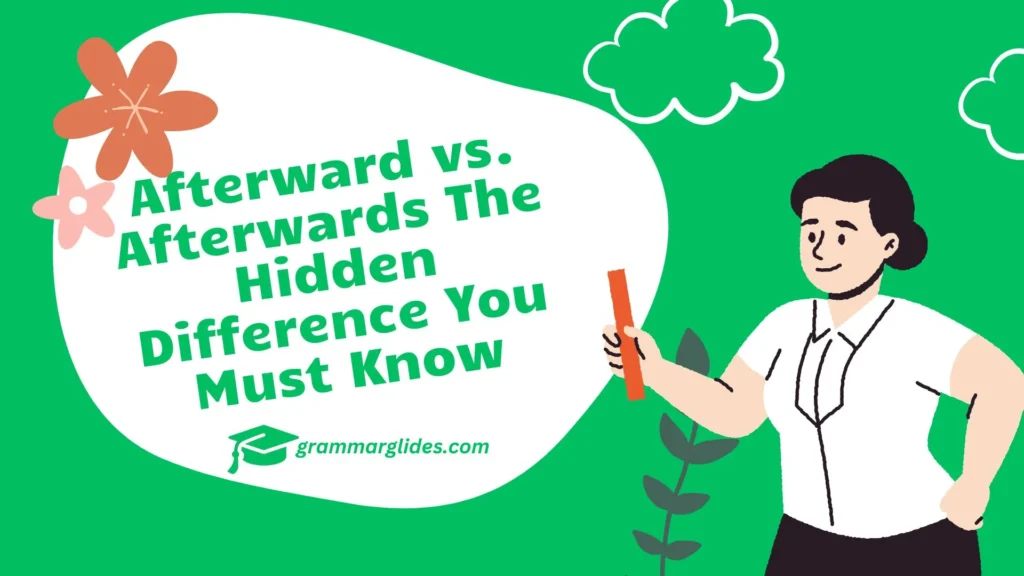“Difference between “afterward” and “afterwards” to perfect your writing!“
The subtle difference between “afterward” and “afterwards” has baffled many people, especially when it comes to using them in sentences. Despite their similar meanings, they have distinct historical and regional origins. Understanding the proper context for each version can clear up confusion, helping you use these terms with confidence. Whether you’re writing, speaking, or reading, knowing when to use “afterward” or “afterwards” enhances your communication skills.
In this blog post, we’ll explore the essential differences between “afterward” and “afterwards,” unravel their historical roots, and provide examples for clarity. You’ll learn how language evolution has shaped the usage of these two terms and why it matters in both American and British English. By the end, you’ll be equipped to use them correctly in your everyday language.
Overview of Afterward vs. Afterwards
While “afterward” and “afterwards” may seem interchangeable, they have different historical backgrounds and regional preferences. Both words function as adverbs that indicate something happening later or after an event. The difference between them is subtle but important, especially when it comes to which form is commonly used in various dialects of English.
In American English, “afterward” is the preferred form, while in British English, “afterwards” tends to be the more common choice. These terms are often used to describe events that occur following something else, but understanding the nuances will help you avoid confusion in writing and conversation.
Defining Afterward and Afterwards
Basic Definitions
Both “afterward” and “afterwards” mean “at a later time” or “subsequently.” They are used to refer to something that happens after an event or action has taken place.
- Afterward: Commonly used in American English, it refers to something happening after something else.
- Afterwards: This term is more frequently used in British English but carries the same meaning.
Usage Notes
While the two words are nearly synonymous, the choice between “afterward” and “afterwards” depends on your location or the style guide you follow. It’s important to be aware of these preferences to ensure you are using the correct form.
The Origins of -ward and -wards Suffixes
Historical Background
Both “afterward” and “afterwards” are derived from Old English. The suffixes “-ward” and “-wards” historically indicated a direction or time, and over time, these suffixes evolved into adverbs. The “ward” suffix generally indicates a direction or tendency toward something, while “-wards” developed as a variation of the same form, often used for emphasis.
Evolution of Language
As English evolved, so did the usage of these suffixes. The shift from “-wards” to “-ward” in American English happened gradually and is a part of how the language has changed over time. Both versions of the word exist today, but regional differences influence which form is more common.
Regional Preferences: Afterward vs. Afterwards
American English
In American English, “afterward” is overwhelmingly preferred. If you are writing for an American audience or publishing in an American context, using “afterward” will feel more natural and align with the typical usage.
Scenario 1: After a Meeting
Example 1: “We had a great meeting, and we decided to grab dinner afterward.” In this case, the meeting is followed by dinner. “Afterward” fits naturally in American English, where this is the preferred form.
British English
In contrast, “afterwards” is the preferred term in British English. If you are writing for a British audience, using “afterwards” will sound more familiar and consistent with the style.
Scenario 2: After a Lecture
Example 2: “We attended the lecture, and we went for coffee afterwards.” In the UK, “afterwards” is more common. The sentence implies that the coffee came after the lecture, and “afterwards” is the natural choice in British English.
Afterward vs. Afterwards
| Aspect | Afterward (American English) | Afterwards (British English) |
| Meaning | Refers to something happening later or subsequently. | Refers to something happening later or subsequently. |
| Usage | Primarily used in American English, in both formal and informal contexts. | Primarily used in British English, in both formal and informal contexts. |
| Part of Speech | Adverb | Adverb |
| Common Confusion | Not commonly confused with “afterword.” | Not commonly confused with “afterword.” |
| Example 1 | “We went for lunch afterward.” | “We went for lunch afterwards.” |
| Example 2 | “The meeting ended, and we spoke afterward.” | “The meeting ended, and we spoke afterwards.” |
| Afterword Confusion | Rarely confused with “afterword.” | Rarely confused with “afterword.” |
| Regional Preference | Preferred in American English. | Preferred in British English. |
Awaiting Approval vs Pending Approval Which One Is Correct?
Contextual Usage in Different Varieties of English
American Publications
In American publications, “afterward” is more common and is generally seen in both formal and informal contexts. It tends to appear more frequently in books, articles, and other forms of media produced in the U.S.
Scenario 3: In an Article
Example 3: “The conference was enlightening, and the speaker answered questions afterward.” This sentence, which could appear in a U.S. article or publication, uses “afterward” to indicate that the questions came after the conference.
British Publications
British publications often use “afterwards”. This is the default form in formal writing, literature, and everyday conversation in the UK.
Scenario 4: In a Report
Example 4: “The team gathered for a discussion afterwards.” In British English, this phrasing is more natural in a formal report or article.
Grammar and Parts of Speech
Adverbial Usage
Both “afterward” and “afterwards” function as adverbs, modifying verbs to indicate when something happens.
Example 1:
Scenario: After a class
- “She left the class early, and we spoke afterward.” Here, “afterward” tells us when the conversation happened—right after the class.
Example 2:
Scenario: After a meeting
- “The group decided to go for lunch afterwards.” “Afterwards” tells us that lunch followed the meeting.
Example 3:
Scenario: After an event
- “They went to the party, but they left early and went home afterward.” In this case, “afterward” shows that leaving the party came later.
Potential Confusion with Other Parts of Speech
The primary confusion arises when “afterward” or “afterwards” is mistakenly used as a noun. However, both terms are adverbs and should not be confused with “afterword,” which is a noun.
Common Confusion with Homophones: Afterward vs. Afterword
Afterword
An afterword refers to a section at the end of a book or document, often written by someone other than the author, providing additional commentary or insights.
Example 1:
- “The afterword provided insightful commentary on the author’s inspiration.”
Practical Examples
Misunderstandings often occur when people confuse “afterword” with “afterward.” It is crucial to distinguish between the two to maintain clarity in your writing.
Example of Confusion:
- “He spoke afterword” (incorrect – it should be “afterward”).
Misunderstandings: Distinguishing Time from Text: Afterward vs. Afterword
Clarifying the Context
The confusion between “afterward” and “afterword” often comes from their similar sounds. While “afterward” is used to talk about time, an afterword relates to written work or the end of a text.
Example 2:
- “She wrote the afterword for the novel.”
Examples and Misunderstandings
Here are some practical examples of how to use “afterward” correctly:
- “We went to the movies afterward.”
- “He offered an insightful afterword to the novel.”
Tips for Remembering the Difference
Memory Aids
A good way to remember the difference between “afterward” and “afterword” is to think of the word “afterword” as a written section at the end of a book, while “afterward” is just the adverb you use for time.
Usage Tips
- Use “afterward” for time-related events (American English).
- Use “afterwards” for the same purpose in British English.
- Remember: “afterword” refers to a written section, not time.
Choosing the Right Term
To recap, the primary difference between “afterward” and “afterwards” is regional usage. American English prefers “afterward,” while British English favors “afterwards.” Both terms are adverbs meaning “at a later time,” but confusion arises when people mistakenly use them as nouns or interchange them with “afterword.”
Understanding these distinctions can help you communicate more effectively and avoid common mistakes. Whether you’re writing for an American or British audience, now you can confidently choose the right term based on context.
Key Insight
1. Is there any difference in meaning between “afterward” and “afterwards”?
Both words have the same meaning, referring to something that happens later or subsequently. The difference is primarily in regional usage, with “afterward” being preferred in American English and “afterwards” in British English.
2. Can “afterword” be used in the same way as “afterward”?
No, “afterword” is a noun that refers to a section at the end of a book or document. It is different from “afterward,” which is an adverb used to describe a time following an event.
3. Is it wrong to use “afterwards” in American English?
While “afterwards” is more commonly used in British English, it is still understood in American English. However, “afterward” is the preferred form in the U.S., especially in formal writing.
4. Can I use “afterward” in both informal and formal writing?
Yes, “afterward” is appropriate for both informal and formal contexts in American English. It’s a versatile adverb used in various settings.
5. Do I need to be aware of regional preferences when writing for a global audience?
Yes, it’s important to be aware of regional preferences, especially if you are writing for a specific audience. If you’re writing for a British audience, “afterwards” would be more suitable. For an American audience, use “afterward.”
Wrap Up
In conclusion, understanding the difference between “afterward” and “afterwards” can help you communicate more effectively and avoid confusion. Both words carry the same meaning but differ in their regional preferences—“afterward” being favored in American English, while “afterwards” is more common in British English.
By paying attention to these subtle distinctions, you can ensure that your writing aligns with the expectations of your intended audience. Additionally, being mindful of the noun form “afterword” will prevent misunderstandings in your communication. Armed with this knowledge, you can confidently choose the right term based on context, whether you are writing for a British or American readership.

Hi! I’m Lauren Reynolds, the author of Grammar Glides. I create easy-to-follow content that helps you master English with confidence. Let’s make learning English simple and enjoyable together!

